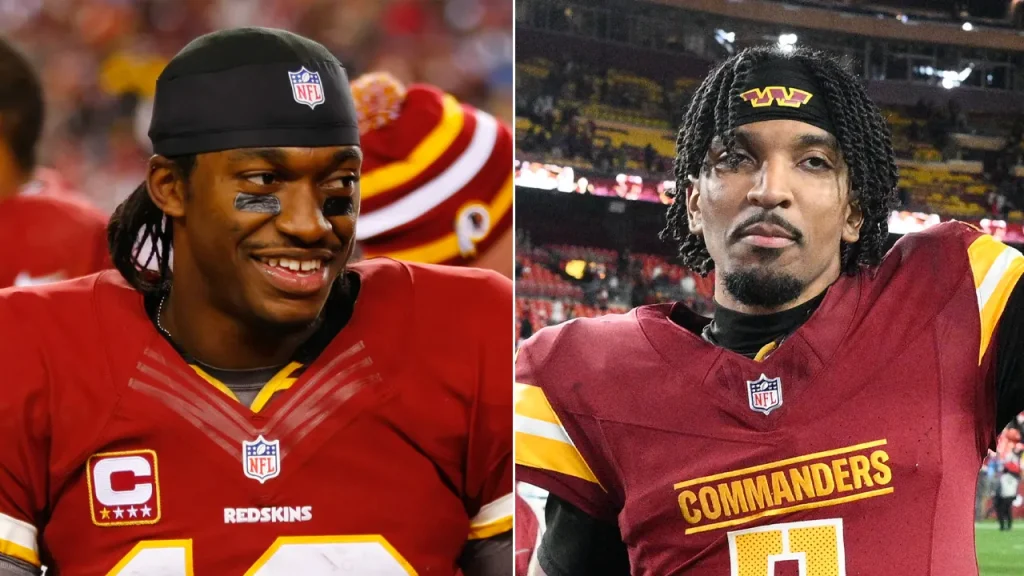The NBC broadcast of “Sunday Night Football” featuring the Washington Commanders’ overtime victory against the Atlanta Falcons sparked controversy surrounding the visual presentation of former quarterback Robert Griffin III. During the game, current Commanders quarterback Jayden Daniels shattered the franchise’s rookie rushing record, surpassing the mark set by Griffin in 2012. As a graphic highlighting Daniels’ achievement alongside Griffin’s rookie season stats appeared on screen, viewers noticed a significant alteration to Griffin’s uniform. The image displayed Griffin without the “Redskins” name emblazoned across his chest, despite the team wearing jerseys featuring the name beneath the NFL logo during that season. This omission, a departure from the historical accuracy of Griffin’s attire, ignited debate and prompted inquiries about NBC’s editorial decision-making process. The network has yet to offer a public explanation for the alteration.
The incident underscores the ongoing sensitivity surrounding the former “Redskins” name and its complex legacy. For years, the name was the subject of intense criticism and protests, with many deeming it offensive and racially insensitive to Native American communities. This pressure eventually led former team owner Daniel Snyder to retire the name in 2020, marking a significant turning point in the franchise’s history. The team adopted the temporary moniker “Washington Football Team” before ultimately settling on the current “Commanders” identity. The decision to remove the “Redskins” name from Griffin’s uniform in the broadcast highlights the ongoing tension between acknowledging historical context and navigating the evolving sensibilities surrounding the controversial name.
The juxtaposition of Daniels’ record-breaking performance and the altered image of Griffin underscores the franchise’s transition from one era to another. Daniels’ impressive rookie season, culminating in his surpassing of Griffin’s rushing record, symbolizes a new chapter for the Commanders. His on-field success, coupled with his leadership and potential, has invigorated the team and generated excitement among fans. Meanwhile, Griffin’s 2012 season, though marred by the controversy surrounding the team name, remains a significant moment in franchise history. He earned Pro Bowl honors and was named Offensive Rookie of the Year, leading the team to a playoff berth. The graphic displaying the two quarterbacks side-by-side, albeit with the alteration to Griffin’s uniform, serves as a visual representation of the team’s evolution and the passing of the torch from one promising quarterback to another.
The controversy surrounding the altered image also highlights the broader conversation regarding the use of Native American imagery in sports and the ongoing efforts to reconcile historical practices with contemporary values. The “Redskins” name, once a source of pride for some fans, became increasingly problematic as societal awareness of racial sensitivity grew. The decision to retire the name was a significant step towards acknowledging the concerns of Native American communities and promoting a more inclusive environment in professional sports. However, the debate surrounding the team’s history and its former imagery continues.
Recent developments involving the new Commanders ownership group, led by Josh Harris, have further complicated the narrative. Harris has engaged in discussions with federal lawmakers regarding the potential revival of the old logo in some capacity, particularly in connection with the possibility of using the RFK Stadium site as the team’s future home. Senator Steve Daines has expressed support for a bill that would facilitate the team’s return to the RFK Stadium site, contingent upon “good faith negotiations” with the league and the franchise to honor the Blackfeet chief logo used by the organization for decades. This development has reignited debate about the appropriateness of using Native American imagery, even in a historical context.
The controversy surrounding the NBC broadcast and the altered image of Robert Griffin III underscores the complexities of balancing historical accuracy with evolving societal values. The “Redskins” name, once a deeply ingrained part of the franchise’s identity, has become a symbol of division and controversy. While some argue for its preservation as a historical artifact, others view it as a painful reminder of a less enlightened era. The decision by NBC to remove the name from Griffin’s uniform, though seemingly a small gesture, reflects the ongoing tension surrounding this issue and the challenges of navigating a sensitive historical landscape. The future of the franchise’s imagery and its relationship to its past remains uncertain as the debate continues.

